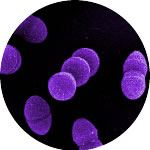Enterococcus faecalis
- Organism Specific Information
- Concatenate Sequences
- Download Alleles
- Download ST’s
- Compare profile to refset
- Draw tree using own MLST data
- download as MS Excel
- download as MS Access
- E.faecalis Links
- eBURST V3
- Contact Curator
Enterococcus faecalis is a type of enterococcus that is part of the normal microflora of the human digestive tract, as well as some mammals.
Fecal enterococci are the most common enterococci in the human body (as well as poultry). Fecal enterococci also colonize the intestines of cattle, pigs, dogs, horses, sheep and goats.
Fecal enterococcus can be the causative agent of various infections: urinary tract, intra-abdominal, pelvic organs, wound, endocarditis. Fecal enterococci, along with the faecium enterococci, are the most pathogenic species among enterococci; they make up 80–90% of all enterococci isolated in the clinical material of humans. Fecal enterococci are often the cause of nosocomial infection.
At the same time, fecal enterococci are part of the normal microflora of the gastrointestinal tract of humans and many vertebrates, play an important role in ensuring the colonization resistance of the mucous membrane. The main habitat of fecal enterococcus in the body is the small intestine, but it also occurs in the colon, spongy part of the urethra, in the genitals, and sometimes in the oral cavity. Fecal enterococci are present in the feces of 90% of adults. The number of fecal enterococci in the external environment is a significant sanitary and epidemiological indicator of its fecal contamination.
Fecal enterococci in the food industry
Fecal enterococci, like other enterococci, are used in the food industry, which uses the ability of enterococci to hydrolyze lactose, ferment milk, effectively suppress pathogenic bacteria in the food itself, as well as their high resistance to acids, salts and high temperatures. Various strains of fecal enterococcus are widely used in the manufacture of various varieties of cheese and dairy products. For this, non-pathogenic strains of enterococcus feces are used, initially selected for these purposes.
Urinary tract infection and fecal enterococci
Bacteriuria – the presence of bacteria in the urine – may be a sign of inflammation in the urinary tract, bladder, kidneys. In the absence of any symptoms, true bacteriuria (urinary tract infection) is diagnosed if there are at least 105 microbial bodies in 1 ml of freshly released urine, otherwise, it is assumed that urine is contaminated when it is collected. If there are symptoms or catheter urine is taken, the diagnostic threshold can be significantly reduced. Often, bacteriuria is not accompanied by any symptoms. In this case, it is called asymptomatic bacteriuria. At the same time, bacteriuria is often combined with symptoms of cystitis, pyelonephritis, prostatitis, urethritis, and also occurs in pregnant women. Asymptomatic bacteriuria does not always require immediate treatment.
One of the causative agents of urinary tract inflammation (UMP) is fecal enterococcus, which accounts for 1 to 18% (depending on the type of disease) of all pathogenic microorganisms detected during bacteriuria. The remaining types of enterococci are practically not found among the causative agents of VMP.
Enterococcus faecalis: antibiotic activity
Antibacterial agents that are active against Enterococcus faecalis are levofloxacin, norfloxacin, rifaximin, nifuratel, doxycycline (not all strains). Enterococcus faecalis is moderately sensitive to ciprofloxacin. 74% of Enterococcus faecalis strains are not sensitive to tetracycline. Lincomycin and clindamycin are not active against Enterococcus faecalis. Enterococcus faecalis are also sensitive to gentamicin, moxifloxacin.
Acute uncomplicated urinary tract infections caused by Enterococcus faecalis nitrofurans are treated by third-generation cephalosporins, gentamicin, fluoroquinolones. It should be noted that cephalosporins lack activity against enterococci, and early fluoroquinolones (lomefloxacin, norfloxacin, ofloxacin, pefloxacin, ciprofloxacin) have weak activity against Enterococcus faecalis.
Enterococcus faecalis in the taxonomy of bacteria
According to modern concepts, the species Enterococcus faecalis belongs to the genus Enterococcus, which is part of the Enterococcaceae family, the order Lactobacillales, class Bacilli, type Firmicutes, Terrabacteria group, the kingdom of Bacteria.
According to the previously adopted classification, enterococci belonged to serogroup D streptococci and Enterococcus faecalis was called Streptococcus faecalis. Traditionally, it is sometimes called fecal streptococcus.


